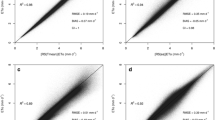Abstract
We propose a new model to estimate daily global radiation from daily temperature range measurements. This model combines that of Majumdar et al. (Sol Energy 13(4):383–394, 1972) to estimate clear sky radiation with a Gompertz function to estimate the relation between temperature range and cloud transmittance. Model parameters are estimated from historical weather data: maximum and minimum temperatures and, if available, relative humidity; no other calibration is required. The model was parametrized and validated using 788 weather stations in Mexico. When calibrated using historical humidity data, daily global radiation was estimated with a mean root mean square error of 3.06 MJ m−2 day−1. The model performed well in all situations, except for a few stations around the Gulf of Mexico and in mountain areas. When using estimated humidity, the root mean square error of prediction was only slightly degraded (3.07 MJ m−2 day−1). Possible theoretical basis and applicability of this model to other environments are discussed.











Similar content being viewed by others
References
Albrecht BA, Fairall C, Thomson A, White A, Snider J (1990) Surface-based remote sensing of the observed and the adiabatic liquid water content. Geophys Res Lett 17:89–92
Allen RG (1996) Assessing integrity of weather data for use in reference evapotranspiration estimation. J Irrig Drain Eng Div ASCE 122(2):97–106
Allen RG, Pereira LS, Raes D, Smith M (1998) Crop evapotranspiration: guidelines for computing water requirements. Irrig Drain Paper 56. UN-FAO, Rome
Baigorria GA, Villegas EB, Trebejo I, Carlos JF, Quiroz R (2004) Atmospheric transmissivity: distribution and empirical estimation around the central Andes. Int J Climatol 24(9):1121–1136
Ball RA, Purcell LC, Carey SK (2004) Evaluation of solar radiation prediction models in North America. Agron J 96:391–397
Bristow KL, Campbell GS (1984) On the relationship between incoming solar radiation and daily minimum and maximum temperature. Agric For Meteorol 31:159–166
Donatelli M, Bellocchi G (2001) Estimate of daily global solar radiation: new developments in the software RadEst3.00. In Proc of the 2nd Int. Symp. Modelling Cropping Systems, 16–18 July. Florence, Italy. p. 213–214. Software available at http://www.sipeaa.it/ASP/ASP2/RadEst.asp
Donatelli M, Carlini L, Bellocchi G (2004) GSRad, un componente software per la stima della radiazione solare. Riv Ital Agrometeorol 1:20–26
Doorenbos J, Pruitt WO (1975) Guidelines for predicting crop water requirements, Irrigation and Drainage Paper 24, Food and Agriculture Organization of the United. Nations, Rome, p 179
Goodin DG, Hutchinson JMS, Vanderlip RL, Knapp MC (1999) Estimating solar irradiance for crop modeling using daily air temperature data. Agron J 91:845–851
Hargreaves GH, Samani ZA (1985) Reference crop evapotranspiration from temperature. Appl Eng Agric 1(2):96–99
Majumdar NC, Mathur BL, Kaushik SB (1972) Prediction of direct solar radiation for low atmospheric turbidity. Sol Energy 13(4):383–394
Mc Donald JE (1963) James Espy and the beginnings of clouds thermodynamics. Bull Amer Meteor Soc 44(19):634–641
Moradi I, Mueller R, Perez R (2014) Retrieving daily global solar radiation from routine climate variables. Theor Appl Climatol 116:661–669
R Development Core Team (2012) R: a language and environment for statistical computing. R Foundation for Statistical Computing, Vienna, Austria. ISBN 3–900051–07-0, URL http://www.R-project.org/
Thornton PE, Running SW (1999) An improved algorithm for estimating incident solar radiation from measurements of temperature, humidity and precipitation. Agric For Meteorol 93:211–228
Weiss A, Hays CJ, Hu Q, Easterling WE (2001) Incorporating bias error in calculating solar irradiance: implications for crop yield simulations. Agron J 93:1321–1326
Zuidema P, Egdeworth RW, Fairall C, Hazen D (2005) Ship-based liquid water path estimates in marine stratocumulus. J Geophys Res 110:1–11
Author information
Authors and Affiliations
Corresponding author
Rights and permissions
About this article
Cite this article
Lobit, P., López Pérez, L. & Lhomme, J.P. Retrieving air humidity, global solar radiation, and reference evapotranspiration from daily temperatures: development and validation of new methods for Mexico. Part II: radiation. Theor Appl Climatol 133, 799–810 (2018). https://doi.org/10.1007/s00704-017-2212-8
Received:
Accepted:
Published:
Issue Date:
DOI: https://doi.org/10.1007/s00704-017-2212-8




